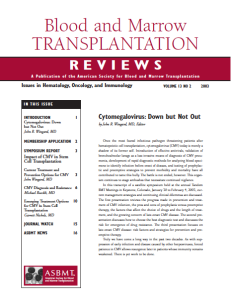Cytomegalovirus: Down but Not Out
by John R. Wingard, MD, Editor
Once the most feared infectious pathogen threatening patients after hematopoietic cell transplantation, cytomegalovirus (CMV) today is merely a shadow of its former self. Introduction of effective antivirals, validation of bronchoalveolar lavage as a less invasive means of diagnosis of CMV pneumonia, development of rapid diagnostic methods for analyzing blood specimens to identify infection before onset of disease, and testing of prophylactic and preemptive strategies to prevent morbidity and mortality have all contributed to tame this bully. The battle is not ended, however. This organism continues to stage ambushes that necessitate continued vigilance.
In this transcript of a satellite symposium held at the annual Tandem BMT Meetings in Keystone, Colorado, January 30 to February 4, 2003, current management strategies and continuing clinical dilemmas are discussed. The first presentation reviews the progress made in prevention and treatment of CMV infection, the pros and cons of prophylaxis versus preemptive therapy, the factors that affect the choice of drugs and the length of treatment, and the growing concern of late-onset CMV disease. The second presentation discusses how to choose the best diagnostic test and discusses the risk for emergence of drug resistance. The third presentation focuses on late-onset CMV disease: risk factors and strategies for prevention and preemptive therapy.
Truly we have come a long way in the past two decades. As with suppression of early infection and disease caused by other herpesviruses, forced patience in CMV allows resurgence later in patients whose immunity remains weakened. There is yet work to be done.
Download a PDF version of the full issue.

